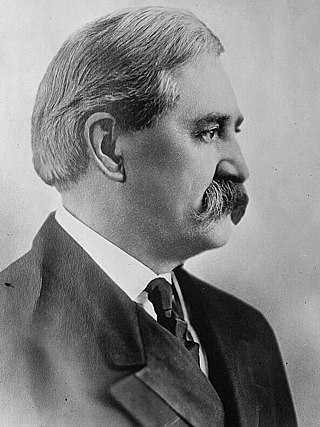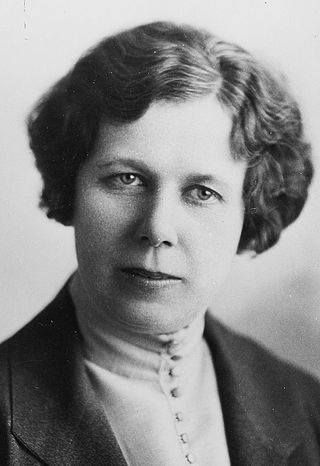
William Boyd Allison was an American politician. An early leader of the Iowa Republican Party, he represented northeastern Iowa in the United States House of Representatives before representing his state in the United States Senate. By the 1890s, Allison had become one of the "big four" key Republicans who largely controlled the Senate, along with Orville H. Platt of Connecticut, John Coit Spooner of Wisconsin and Nelson W. Aldrich of Rhode Island.

Daniel Frederic Steck, was the only Iowa Democrat in the United States Senate between the American Civil War and the Great Depression. He was sworn in as senator only after an extraordinary election challenge, in which his apparent defeat at the polls by a Progressive Party ally running as a Republican was reversed by a Republican-controlled U.S. Senate over seventeen months later.

Smith Wildman Brookhart, was twice elected as a Republican to represent Iowa in the United States Senate. He was considered an "insurgent" within the Republican Party. His criticisms of the Harding and the Coolidge administrations and of business interests alienated others in the Republican caucus and led to his ouster from the Senate over an election challenge.

Albert Baird Cummins was an American lawyer and politician. He was the 18th governor of Iowa, elected to three consecutive terms and U.S. Senator for Iowa, serving for 18 years. Cummins was a leader of the Progressive movement in Washington and Iowa. He fought to break up monopolies. Cummins' successes included establishing the direct primary to allow voters to select candidates instead of bosses; outlawing free railroad passes for politicians; imposing a two-cent street railway maximum fare; and abolishing corporate campaign contributions. He tried, with less success, to lower the high protective tariff in Washington.

The 1926 United States Senate elections were elections for the United States Senate that occurred in the middle of Republican President Calvin Coolidge's second term. The 32 seats of Class 3 were contested in regular elections, and special elections were held to fill vacancies. The Republican majority was reduced by seven seats.

Gladys Shields Pyle was an American educator, politician and the first woman elected to the United States Senate without having previously been appointed to her position; she was also the first female senator to serve as a Republican and the first female senator from South Dakota. Further, she was the first female senator from outside the south. She was also the first unmarried female senator.

William Henry McMaster was an American politician who served as the tenth Governor of South Dakota from 1921 until 1925. A member of the Republican Party, he went on to serve as a member of the United States Senate from South Dakota from 1925 to 1931.

David Wallace Stewart served as a United States senator from Iowa from August 7, 1926, until March 3, 1927, serving out the unexpired term of a senator who died soon after he was defeated for re-election in a Republican primary.

Lester Jesse Dickinson was a Republican United States Representative and Senator from Iowa. He was, in the words of Time magazine, "a big, friendly, white-thatched Iowa lawyer." In early 1936, he dreamed of winning the presidency. However, the only race he would enter that year would be for his own seat in the Senate which he lost.

Burton Erwin Sweet was a four-term Republican U.S. Representative from Iowa's 3rd congressional district, then a wide but short chain of counties in north-central and northeastern Iowa, in the shape of a monkey wrench.

Charles Edgar Pickett was a two-term Republican U.S. Representative from Iowa's 3rd congressional district.

The 1926 New York state election was held on November 2, 1926, to elect the governor, the lieutenant governor, the state comptroller, the attorney general, a U.S. Senator, the chief judge and an associate judge of the New York Court of Appeals, as well as all members of the New York State Assembly and the New York State Senate. A referendum to repeal Prohibition was also proposed and accepted by a very large majority.

Claude Rodman Porter was an American politician and lawyer. He served in both chambers of the Iowa General Assembly and as a United States Attorney, and was a perennial Democratic Party runner-up to Republican victors in three races for governor of Iowa and six races for U.S. senator. In an era in which the Republican Party was so dominant in Iowa that Senator Jonathan P. Dolliver remarked that "Iowa will go Democratic when Hell goes Methodist," Porter twice came closer to winning the governorship than all but one other Democratic candidate of that era. He later served as a member of the U.S. Interstate Commerce Commission for eighteen years.

Randall Lee Feenstra is an American politician and businessman serving as the U.S. representative for Iowa's 4th congressional district. The district covers the western border of the state, including Sioux City and Council Bluffs, but stretches as far east as Story County, Franklin County, and Marshall County, including Ames.

The 1932 United States Senate election in Iowa took place on November 8, 1932. Incumbent Republican Senator Smith Brookhart, a controversial progressive figure within the conservative Iowa Republican Party, was defeated in the June Republican primary by Henry A. Field. Field was in turn defeated in the general election by Democrat Louis Murphy. Brookhart also entered the general election as the candidate of the Progressive Party but finished a distant third.

The 1924 United States Senate election in Iowa took place on November 4, 1924. Incumbent Republican Senator Smith W. Brookhart ran for re-election to a full term in office against Democrat Daniel F. Steck.

The 1920 United States Senate election in Iowa was held on November 2, 1920. Incumbent Senator Albert B. Cummins was re-elected to a third term in office, defeating challenges from Smith W. Brookhart in the Republican primary and Claude R. Porter in the general election.

The 1922 United States Senate special election in Iowa took place on November 7, 1922. Republican Smith W. Brookhart was elected to complete the unexpired term of William S. Kenyon, defeating Democrat Clyde Herring.

The 1930 United States Senate election in Iowa took place on November 4, 1930. Incumbent Democratic Senator Daniel F. Steck ran for re-election to a full term in office, but was defeated by U.S. Representative Lester J. Dickinson.

The 1936 United States Senate election in Iowa took place on November 3, 1936. Incumbent Republican Senator Lester J. Dickinson ran for re-election to a second term but was defeated by Democratic Governor Clyde Herring.





















